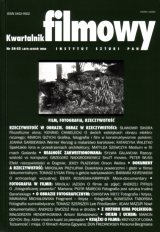Dialektyka powierzchni i głebi w filmie dokumentalnym
The dialectic of surface and depth in the documentary film
Author(s): Mirosław PrzylipiakSubject(s): Theatre, Dance, Performing Arts
Published by: Instytut Sztuki Polskiej Akademii Nauk
Keywords: Direct Cinema; documentary
Summary/Abstract: The essay deals with a series of problems relating to concepts of surface and depth in the documentary film. The starting point of the essay is the issue of American Direct Cinema, the approach to filmmaking, created by the people who wanted to reflect reality in the cinema and believed that the plan was feasible. In their films, they repeatedly emphasized that they wanted to capture life the way it really is and convey what really happens. Mirosław Przylipiak writes, first and foremost, about the language used in the discourse on documentary filmmaking and the intellectual guidelines manifesting in the language. Citing frequently differing critical points of view and opinions, he focuses on that group of views that translated the discourse on direct cinema into the language and terminology of idealism. Thus, instead of asserting that direct cinema shows (reality) or transports (the viewer to a place of events), the critics say that cinema reveals. The image of reality ceases to be an aim and becomes a vehicle, a sign and a signal leading towards something that is invisible, which needs to be revealed. We no longer speak of reality but of the essence of reality. Drawing on Hannah Arendt’s theory, Przylipiak reflects on dualism, so deeply rooted in philosophy: the imitation- prototype dualism, the surface-essence dualism, the idea-reflection dualism. In the end he asserts after Arendt that the two-world theory is a mistake of metaphysics and that the greatest mistake of the mistake lies not in distinguishing an appearance
Journal: Kwartalnik Filmowy
- Issue Year: 2006
- Issue No: 54-55
- Page Range: 146-162
- Page Count: 17
- Language: Polish

